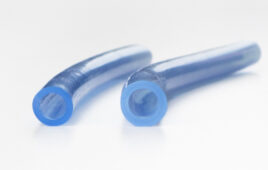Thomas Black | Vice President | OEM | International Divisions Sales and Marketing| B. Braun Medical Inc.
It can be challenging to pick among the thousands of industry resources. From the beginning, companies looking to outsource medical device manufacturing face a major strategic decision. Should we opt for a selection of independent service providers or a single-source contract manufacturer that can handle every step of the process?
Piecing together a collection of resources has its advantages, in finding companies that specialize in processes and techniques that are particularly well-suited to a specific device – a dream team of partners who are the leaders in their respective disciplines. Companies may opt for a collection of suppliers that share a focus on speed or cost savings, for example. Another option is to simply work with established vendors out of familiarity.
More often, however, the decision to use multiple suppliers on a medical device can have a variety of unintended consequences. These could delay the project timeline, increase costs and lower finished quality, in addition to creating undue workload and stress for the internal project team. The movement toward a vertically integrated, single-source contract manufacturer has many benefits.
Reduce supplier audits and validation
Consolidating design and engineering functions with manufacturing provides significant synergies. The design team will lean heavily toward materials and components from suppliers who have already been audited and are part of the company’s existing supply chain.

Quality needs to be designed into the product based on the capabilities and limitations of the manufacturing equipment and processes that will be used to create the device.
Auditing and qualifying new suppliers can take weeks or longer, and consume hours of time. Three professionals each spending 20 hours on an audit account for a total of 60 hours that could be allocated more productively, not to mention the cost of their salaries and the expenses associated with the audit. Similarly, engineers typically design devices with pre-validated components and materials from these suppliers, eliminating the time and expense required for the validation process.
Although multiple vendors can all be ISO-certified and follow similar quality protocols, there is no assurance that their data monitoring, collection and storage systems will be compatible. Proper documentation is essential if a quality issue occurs or an FDA inquiry is made. Continuity of data is just as critical as the continuity of engineering or manufacturing processes.
Minimize variability
Engineers intimately familiar with their manufacturing processes understand how to optimize the design to make the most of their equipment and processes while minimizing manufacturing variability. Quality needs to be designed into the product based on the capabilities and limitations of the manufacturing equipment and processes that will be used to create the device. Even the most automated pieces of equipment have variations, and even the most rigorously controlled assembly operation has idiosyncrasies. Thankfully, engineers can account for limitations with smart design. After all, quality can’t be inspected into the product. It needs to be designed and built in.
Another example of design-manufacturing cooperation involves designing for sterilization. Without meticulous coordination, a separate design team might select a valve and tubing configuration that would not permit ethylene oxide to flow completely through the device. Alternatively, an engineer could select a component that would discolor under gamma sterilization. Complete communication and understanding of all phases of manufacturing among all team members mitigates the likelihood of downstream problems.
Furthermore, it’s essential that all parties involved with the process have the same interpretation of the user requirements document. An engineering team that writes the document one way and a manufacturing team that interprets it differently could mean a final product that’s inconsistent with the desired function. A comparable problem can occur with quality specifications. And measurement capabilities vary from manufacturer to manufacturer. Are they using the same equipment and is it consistently calibrated? The more entities involved in the process, the more unpredictable the outcome.
Reduce management time
Compiling a team of separate vendors places the responsibility for coordinating them with the internal project management team. Each vendor must be aware of its role in the process and when it will occur. Working with an integrated contract manufacturer eliminates the need to manage multiple vendors. One project manager is responsible for the entire timeline from the earliest design stages through assembly and sterilization.
Additionally, the development of an integrated project timeline minimizes delays between stages of the manufacturing process. A seamless transition is critical. If parties are not talking to one another, they will never understand the upstream requirements of the product. It’s analogous to having adjacent conveyor belts. If they’re too far apart, items will fall through the crack. If there’s an overlap, items will pile up.
The issue of accountability is a final benefit. If there is a product failure or quality issue with a device that involves multiple vendors, it’s unlikely that one of them will step forward and take ownership of the problem. The more likely scenario is a round of finger-pointing followed by a call to the lawyers. Centralize the entire process with an integrated manufacturer and there’s no question about who is responsible for resolving an issue. As one client expressed, he likes having “one throat to choke.”
Prepare for a long product lifecycle
Although a collection of multiple vendors could occasionally prove advantageous in the short term, the use of an integrated contract manufacturer delivers benefits over a product lifecycle. For example, a contract manufacturer that also provides sustaining engineering capabilities will be better able to address improvements and changes to the product as feedback returns from the field. Does tubing length need to be changed? Or do pressure requirements need adjusting to ensure proper device operation? An integrated team can evaluate options from a sustaining standpoint, rather than starting anew. As with initial design, they can work as a team to update components and processes without triggering the need to conduct additional auditing or validation.

Measurement and testing capabilities can vary from company to company. Multiple vendors may use different testing equipment or procedures that could cause issues with quality control.
Likewise, the longer an integrated team works on a medical device from design through production and sterilization, the more institutional knowledge they can provide. Rather than acting as a disparate collection of independent vendors, a vertically integrated contract manufacturer acts as a full extension of the customer’s team to provide critical insight and history about everything from material selection to engineering. They also have a holistic understanding of how and why the product has evolved to the current state, providing knowledge that offsets employee turnover or corporate restructuring on the customer side.
Finally, the extent of the partner’s experience should also be considered when evaluating a product lifecycle. Should a product prove successful in one country, is the contract manufacturer prepared to provide engineering guidance, change packaging, or obtain regulatory approvals to enable distribution outside of the original country of manufacture? Can they use components that have already been validated by each country’s regulations? Once again, an integrated multi-national team provides meaningful, fruitful guidance where individual service providers might struggle.
Which model works best?
Of course, no one model works best for every company. Some might opt for an approach akin to selecting a group of “All Stars” to play together on the same field. Individual aptitude, however, doesn’t always lead to excellent team performance, which is essential for something as involved and critical as a medical device.
As the design, production and distribution of medical devices become increasingly complicated and regulated, there’s tremendous value in consolidating resources with a single contract manufacturer that provides an integrated team to steward a product from conception through many years of production. The long-term benefits in terms of time to market, overall quality, thoroughness of documentation and accountability typically will outweigh any perceived short-term benefits of a multiple-source approach.




